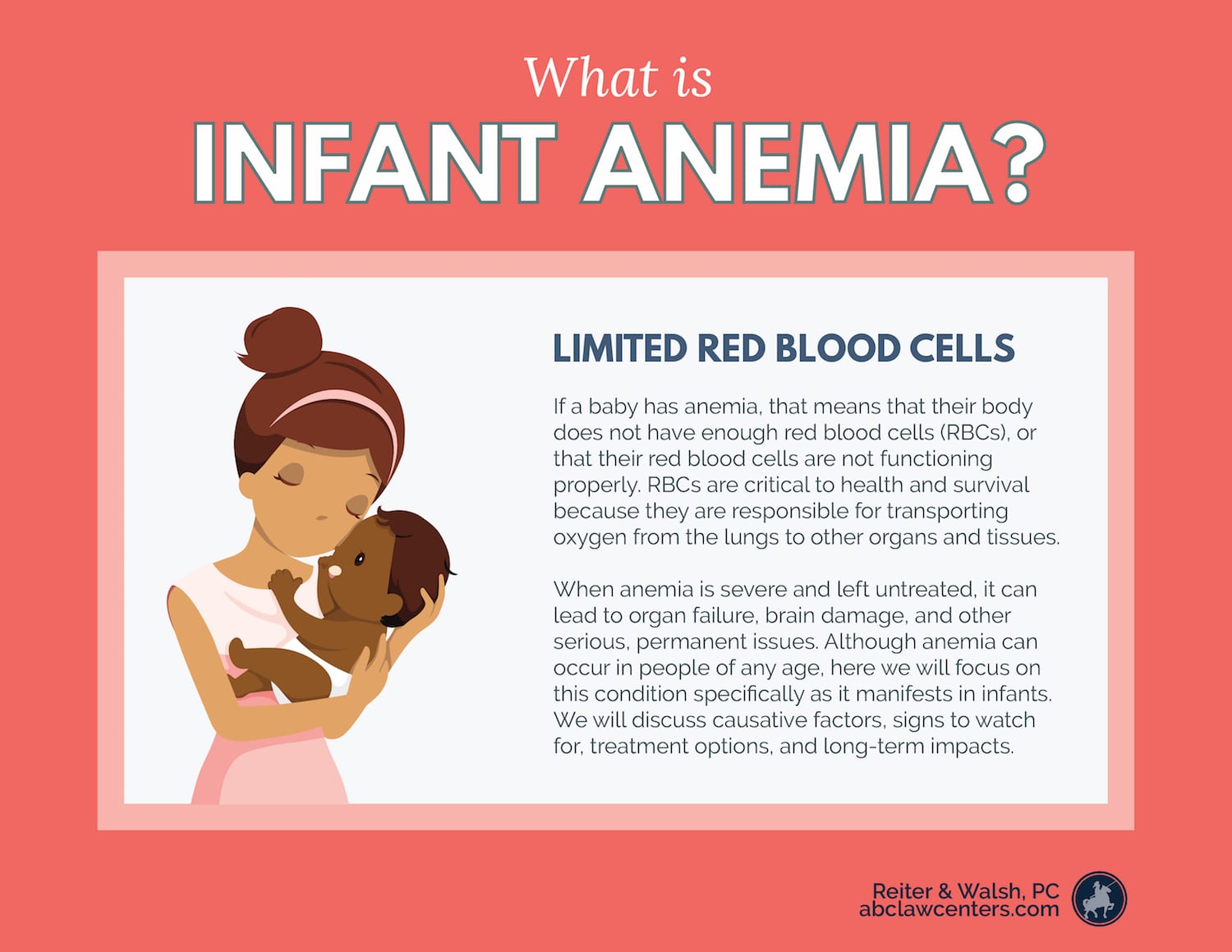Anemia in Infants
If a baby has anemia, that means that their body does not have enough red blood cells (RBCs), or that their red blood cells are not functioning properly. RBCs are critical to health and survival because they are responsible for transporting oxygen from the lungs to other organs and tissues. When anemia is severe and left untreated, it can lead to organ failure, brain damage, and other serious, permanent issues. Although anemia can occur in people of any age, here we will focus on this condition specifically as it manifests in infants. We will discuss causative factors, signs to watch for, treatment options, and long-term impacts.

Causes of anemia in infants
It is common for infants to have a lowered red blood cell concentration after birth. This is called physiologic anemia and occurs because increased tissue oxygenation leads to a decrease in the production of RBCs. Physiologic anemia is typically asymptomatic (1).
Pathologic anemia in infants is more likely to cause injury. It involves a lower level of hemoglobin (the protein in RBCs that transports oxygen), and unlike physiologic anemia, is often symptomatic.
There are three main causes of pathological anemia in early infancy (2, 3):
- Blood loss, which may be due to obstetrical incidents such as:
- Placental abruption
- Placenta previa
- Trauma during birth
- In-utero exchange of blood between twins (twin-twin transfusion), with the mother, or with the placenta
- Internal hemorrhaging
- Blood sampling for laboratory testing
It is important to note that infants have a small blood volume, and are therefore at high risk of experiencing anemia due to blood loss.
- Red blood cell destruction, which can be caused by:
- Hereditary problems
- An immune hemolytic disease, such as Rh incompatibility
- Infections
- Vitamin deficiencies
- Certain drugs
- Inadequate or faulty production of red blood cells, which may be related to:
- Anemia of prematurity*
- Bone marrow disorders
- Nutritional anemia
*Premature babies are born with lower hematocrit (percentage of whole blood that is made up by red blood cells) and hemoglobin than term babies, and their red blood cells also have a shorter lifespan. Moreover, premature infants have underdeveloped livers, which causes impaired production of red blood cells. For all of these reasons, preemies are at higher risk for developing anemia, termed “anemia of prematurity.” Anemia of prematurity is often more severe than that experienced by term babies (2).
Signs of anemia in infants
Sometimes, babies with anemia will be asymptomatic. However, others show more obvious signs, such as the following (2, 4):
- Paleness or jaundice (the baby’s skin and the whites of the eyes may appear yellowish)
- Irritability
- Lethargy
- Respiratory problems
- Tachycardia (rapid heart rate) or bradycardia (slow heart rate)
- Hypotension
- Acidosis
- Inadequate urine output or dark urine
- Feeding problems
- Lack of growth
Treatment options for infants with anemia
The appropriate treatment for an infant with anemia varies based on the type and severity of anemia they are experiencing. Babies whose anemia has been caused by rapid blood loss normally receive fluids via IV and an immediate blood transfusion. For more information on red blood cell transfusions for babies with anemia, please visit our extensive page on this topic.
If anemia is the result of a hemolytic disease (in which red blood cells are destroyed due to immune system incompatibility between the baby and mother), approaches vary. Babies with severe anemia caused by hemolytic disease may require a typical blood transfusion. However, in some cases, an exchange transfusion is an option. During an exchange transfusion, a small amount of the newborn’s blood is removed and replaced with equal amounts of blood from a donor. This can lower the level of bilirubin (a byproduct of red blood cell breakdown that, when in excess, can cause jaundice and even permanent brain damage) and increase the number of healthy red blood cells.
Physicians may also recommend that babies with anemia receive iron supplements, which will help to increase their red blood cell count.
Additionally, it is important to address any underlying causes of anemia, as well as associated complications. For example, babies with jaundice may require treatment with phototherapy, which can help lower their bilirubin levels (5).
Long-term outcomes for mismanaged infant anemia
When promptly diagnosed and treated, infants with anemia may make a full recovery. However, if doctors fail to recognize warning signs of anemia and/or provide proper medical management, this can result in serious harm and constitutes medical malpractice.
Infants with severe anemia, especially those who receive inadequate care, are vulnerable to complications such as organ failure and permanent brain damage.
Legal help for mismanaged infant anemia
If you suspect that your baby suffered a permanent injury from mismanaged anemia, you may want to consider pursuing legal action. The attorneys at ABC Law Centers: Birth Injury Lawyers focus exclusively on malpractice that occurs during pregnancy, birth, or early infancy. They also work closely with an in-house medical team, which enables them to delve deeper into complex medical issues. To find out if you have a case, please reach out for a free case review. We have numerous testimonials and multi-million dollar verdicts and settlements that attest to our success, and you pay nothing unless we win your case.